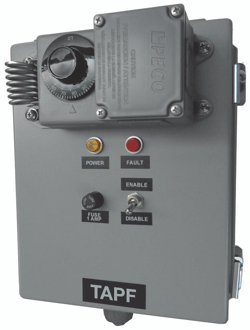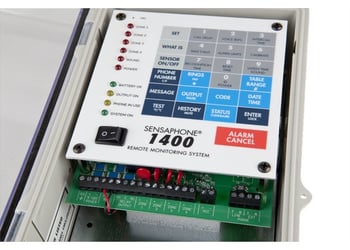Engineers and property owners alike want assurance that the water equipment inside their aluminum enclosures will not freeze. This is especially a concern for people in the northern United States and Canada, but after significant freeze events in recent years throughout the South, this is now a necessary consideration anywhere in North America.
For proper freeze protection, you should be using a heated enclosure that meets the ASSE 1060 Class 1 standard. This means the heated enclosure was designed to maintain a temperature within the enclosure of at least 40°F when the outside temperature is as low as -30°F. By choosing a Class 1 enclosure, you'll know your equipment is protected against freezing under normal and most extreme operating conditions found in the U.S.
What happens if the pump or valve heater fails? What happens if the heater loses power? Fortunately, there are monitoring options to ensure the equipment inside your enclosure stays at a functional temperature and operational integrity is maintained. Various enclosure monitors on the market include ones that provide a strobe light and audible alarm, and ones that can alert the equipment owner via phone, push notification or email.
Below is an overview and comparison of some available enclosure monitoring and alert options.
Pump and Valve Enclosure Monitoring System Options
TAPF (Temperature Alarm Power Failure)
 Safe-T-Cover has an off-the-shelf TAPF system that will alert you whenever the inside temperature drops below a predefined threshold. That set point is determined by the customer, and typically is set at 38-40°F. It also triggers an alert if there is a power failure on the electrical circuit supplying the heater. The TAPF has both a visible strobe light signal and an audible alarm. The TAPF monitor also has an extra set of contacts, so that an alarm signal can be run into a nearby control room. It also has a DC charger that will power the strobe and audible alarm in the event of a power failure. Typically, this DC battery will power alarms for up to 10 hours.
Safe-T-Cover has an off-the-shelf TAPF system that will alert you whenever the inside temperature drops below a predefined threshold. That set point is determined by the customer, and typically is set at 38-40°F. It also triggers an alert if there is a power failure on the electrical circuit supplying the heater. The TAPF has both a visible strobe light signal and an audible alarm. The TAPF monitor also has an extra set of contacts, so that an alarm signal can be run into a nearby control room. It also has a DC charger that will power the strobe and audible alarm in the event of a power failure. Typically, this DC battery will power alarms for up to 10 hours.
Hubbell
Hubbell® carries alarm systems similar to the Safe-T-Cover TAPF. These alarms are triggered whenever there is a power failure or the inside temperature drops below an established threshold. Hubbell has a total of five different alarm options featuring a strobe light, an audible alarm or both.
Supco TA-2 Alarm
AquaShield® resells a simple alarm system provided by Supco®. The Supco TA-2 alarm is an inexpensive audible alarm that was initially developed for refrigerator and freezer applications, but is also suitable for heated enclosures. A key note: the Supco TA-2 alarm lacks a DC battery and does not work in the event of power failure.
Sensaphone Call Out Alarms
 Safe-T-Cover also offers the Sensaphone® alarm. This alarm will automatically dial telephone numbers for established contacts whenever the temperature drops below a chosen set point or in the event of power loss. Up to eight people can be called in sequential order in the event of an alarm. You can even customize the alert message, much like setting up your voicemail. Sensaphone models also include a backup battery in the event of power loss. Data can also be accessed anytime via smartphone.
Safe-T-Cover also offers the Sensaphone® alarm. This alarm will automatically dial telephone numbers for established contacts whenever the temperature drops below a chosen set point or in the event of power loss. Up to eight people can be called in sequential order in the event of an alarm. You can even customize the alert message, much like setting up your voicemail. Sensaphone models also include a backup battery in the event of power loss. Data can also be accessed anytime via smartphone.
The Sensaphone 1400 Monitoring System calls out through a landline and you can set up to four voice messages that will go out in case of a temperature drop. The Sensaphone Sentinel model uses a cellular modem and you can set up an unlimited number of email, text and phone calls to go out in case of a problem. Sensaphone alarms can also tap into any existing SCADA system being used to monitor other valves and pumps within the system. You'll want to use the cellular Sentinel model if your heated enclosure is in a remote location. At last check, there is an annual fee associated with the Sentinel model.
Be Prepared for Power Failure: Have an Alert System in Place
Part of keeping your equipment safe is having a plan in place if the power fails or the interior temperature of your heated enclosure suddenly drops. These alarms will alert you in these instances and ultimately, it's your decision which is the best way for you or your team to be notified. If someone is on site at all times, a strobe and audible alarm may suffice. However, if your equipment is in a remote location, or there are long time gaps when no one is present, then one of the Sensaphone style models may be a better option for you.
No matter what you choose as your alarm system, you'll also need to have a plan ready in case trouble does arise and you need an alternative source of heat. One possibility to consider is to have a 9,000 BTU portable propane heater on standby.
Your Safe-T-Cover enclosure will withstand quite a bit, is built to last and is ASSE 1060 rated. Our exclusive slab-mounted heater is designed for low-profile durability, resists wetness and moisture and provides freeze protection meeting the Class 1 standard. It's always a safe choice to be aware of what's happening in your enclosure at all times, especially in these times of the year when seasons begin to change and conditions lend themselves to regular freeze-thaw cycles.
Contact us for your aluminum enclosure needs, review our standard sizing guide or schedule a consultation with a custom enclosure specialist who can consult you on the features and accessories you need to best protect your investment in your equipment.




